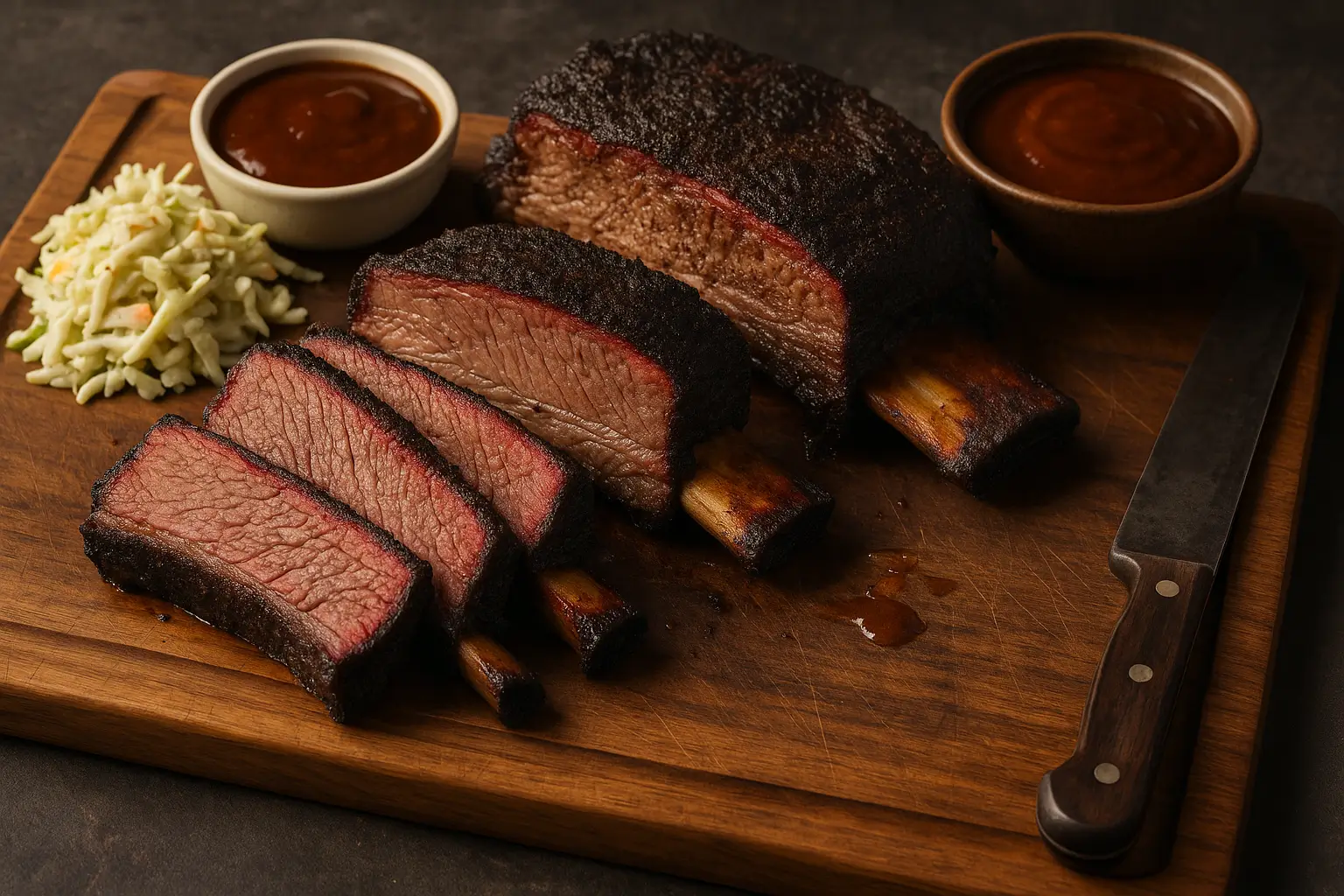There’s something almost mystical about transforming a tough, intimidating slab of beef into fork-tender, smoke-kissed perfection. Smoked beef short ribs represent the pinnacle of barbecue mastery—a dish that rewards patience, technique, and passion with an eating experience that borders on transcendent. This comprehensive guide will take you on a journey from selecting the perfect cut to achieving that coveted « probe-like-butter » tenderness that separates amateur backyard cooks from true pitmasters.
Whether you’re a weekend warrior looking to impress family and friends or an aspiring pitmaster ready to tackle one of barbecue’s most challenging yet rewarding cuts, this smoked beef short ribs recipe will equip you with everything you need to succeed. We’ll cover equipment selection, preparation techniques, smoking methods, troubleshooting common issues, and expert tips that typically take years to master.
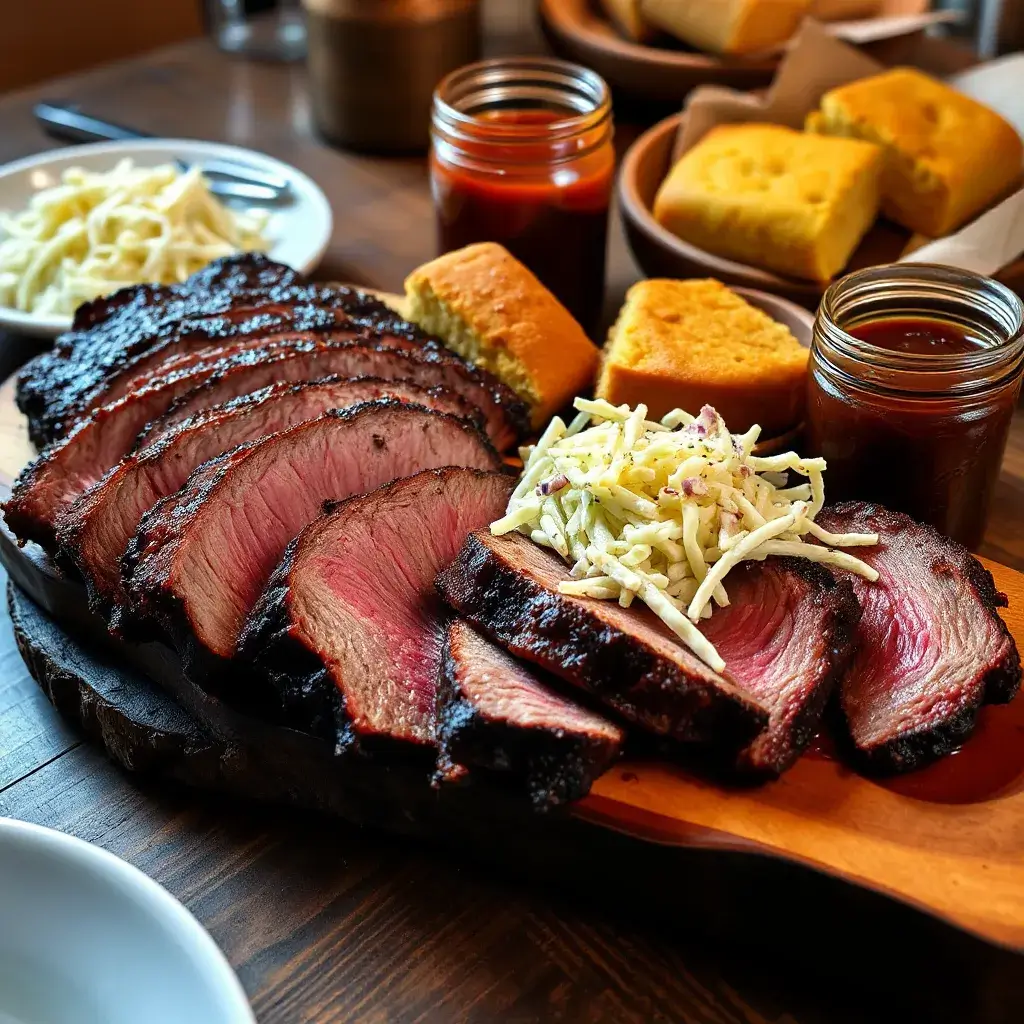
Before we dive in, you’ll need a reliable smoker, a good thermometer, quality beef short ribs, and most importantly—patience. The reward for your dedication will be short ribs smoked to perfection that literally fall off the bone.
Understanding Beef Short Ribs: The Foundation of Success
Not all beef ribs are created equal, and understanding the different cuts is crucial for success when you smoke beef short ribs.
The Cuts Explained
Plate Ribs (NAMP 123) are the holy grail for smoking. These massive, meaty ribs come from the lower portion of the cow’s rib cage and can weigh anywhere from 2-4 pounds per rack. What makes them special is their incredible marbling, thick fat cap, and substantial meat-to-bone ratio. The intramuscular fat and connective tissue break down beautifully during the long, slow smoking process, creating that signature tender texture.
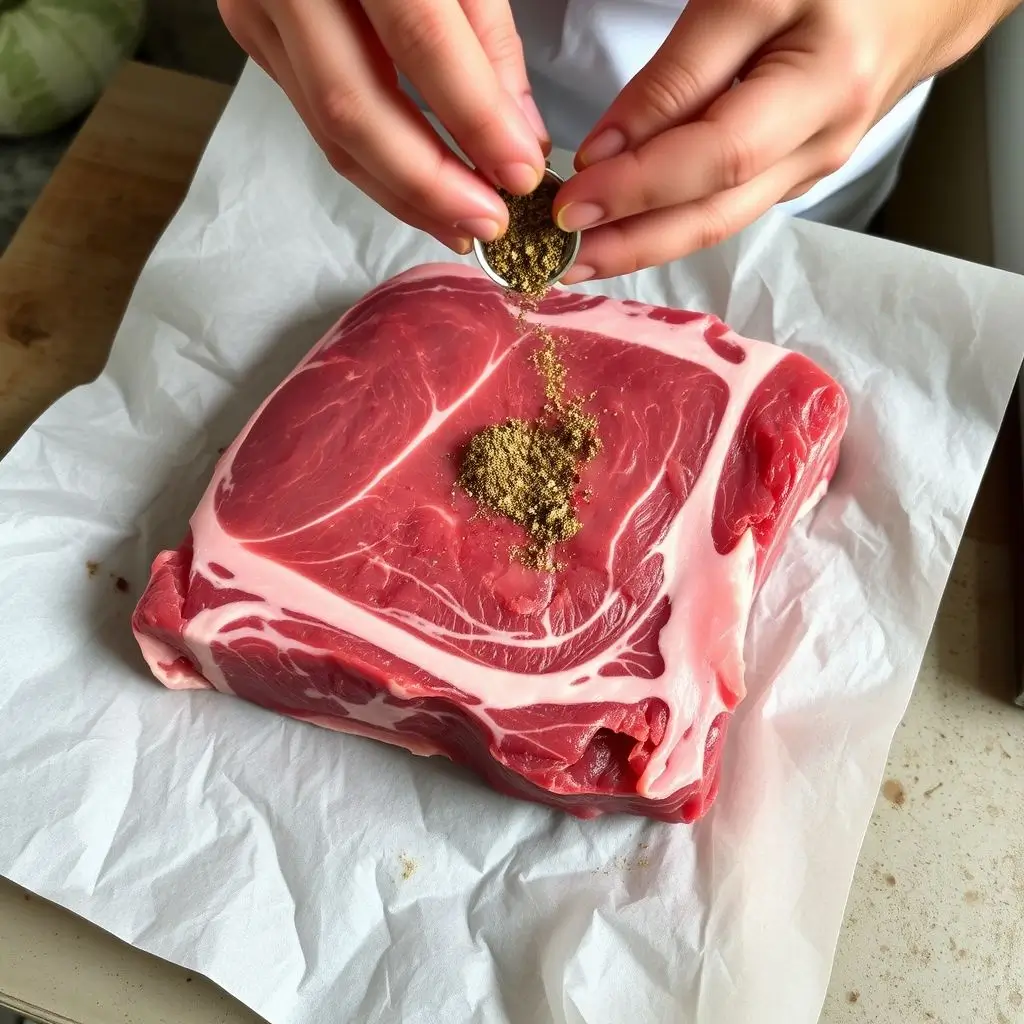
Chuck Short Ribs (NAMP 130) are smaller and come from the shoulder area. While they can be smoked successfully, they lack the impressive presentation and generous meat portions of plate ribs. They’re better suited for braising or faster cooking methods.
Flanken-Cut Ribs are cut across the bones rather than between them, creating thin strips perfect for Korean galbi but unsuitable for traditional smoking.
Quality & Sourcing
When selecting ribs for your smoked beef short ribs recipe, look for:
- Heavy marbling throughout the meat
- A thick, creamy white fat cap (at least ½ inch)
- Bright red meat without dark spots
- Firm bone structure without cracks
- Minimal trimming required
Ask your butcher for « plate ribs » or « beef short ribs, bone-in » and specify you want them cut between the bones, not across them.
Equipment Essentials: Your Pitmaster Arsenal
Success with smoked beef short ribs depends heavily on having the right equipment and understanding how each type performs.
Smoker Types Comparison
| Smoker Type | Pros | Cons | Best For |
| Pellet Smoker | Set-and-forget convenience, consistent temperature | Less authentic smoke flavor, electricity required | Beginners, consistent results |
| Offset Smoker | Traditional BBQ flavor, pure wood smoke | Requires constant attention, steep learning curve | Experienced pitmasters, authentic flavor |
| Kamado Grill | Excellent heat retention, fuel efficient | Limited capacity, expensive | Small batches, versatility |
| Electric Smoker | Easy temperature control, apartment-friendly | Artificial smoke flavor, limited capacity | Urban dwellers, simplicity |
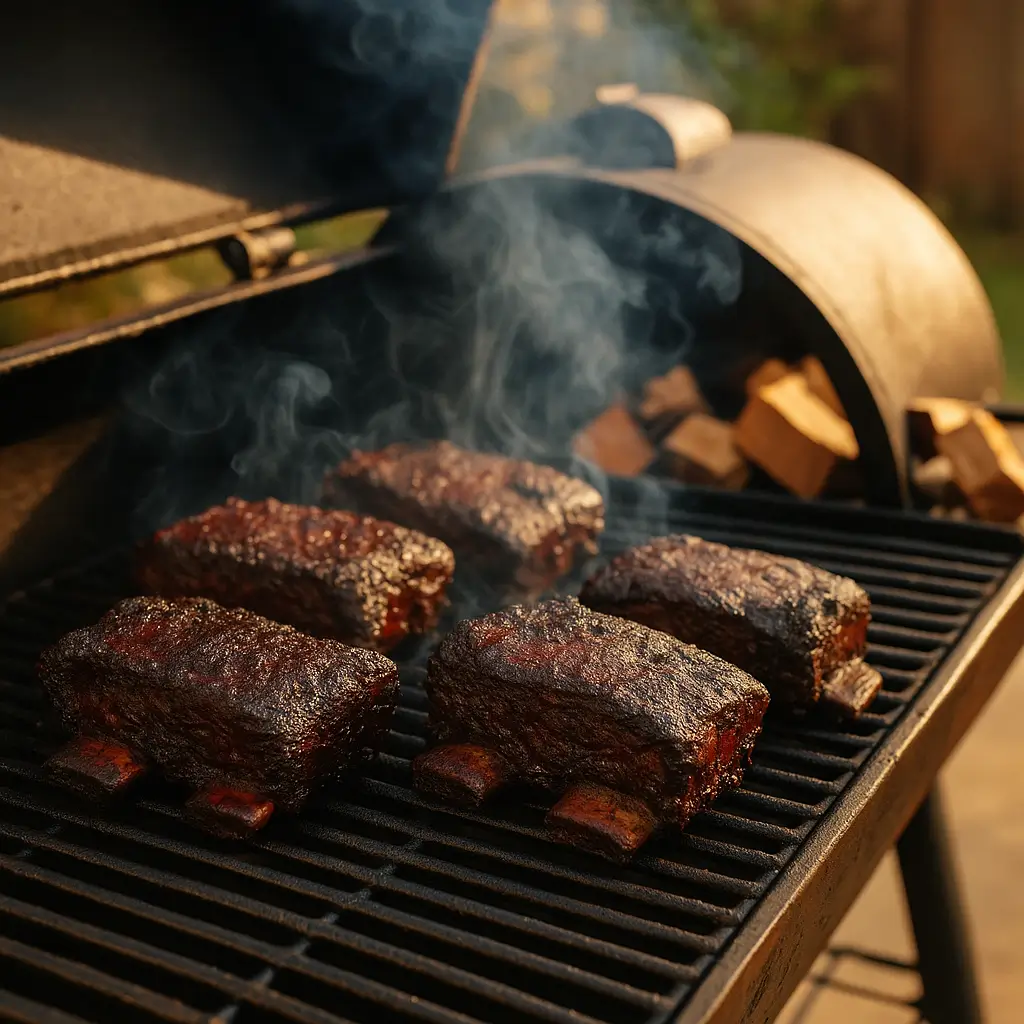
Must-Have Tools
- Dual-probe wireless thermometer for monitoring both pit and meat temperature
- Instant-read thermometer for quick temperature checks
- Spray bottle for spritzing during the cook
- Butcher paper and aluminum foil for wrapping
- Sharp boning knife for trimming
- Large cutting board with juice groove
Wood Selection: The Science of Smoke
The choice of wood dramatically impacts flavor development in your smoked beef short ribs. Here’s what you need to know:
Best Woods for Beef Short Ribs
| Wood Type | Flavor Profile | Smoke Intensity | Best Used With |
| Post Oak | Mild, slightly sweet | Medium | Texas-style beef ribs |
| Red Oak | Clean, mild | Medium | All-day smoking |
| Pecan | Nutty, sweet | Medium-Light | Mixed with stronger woods |
| Cherry | Fruity, mild | Light | Color enhancement |
Avoid mesquite for long cooks—its intense flavor can become overwhelming during the 8-12 hour smoking process.
Prep Masterclass: Setting Up for Success
Proper preparation is where champions are made.
Trimming Beef Short Ribs: Step-by-Step
- Remove the membrane: Check the bone side for a thin, silvery membrane. If present, use a knife to lift one corner and pull it off with paper towels.
- Trim the fat cap: Reduce the thick fat layer to approximately ¼ inch. This allows smoke penetration while retaining moisture.
- Remove hard fat and silverskin: Cut away any hard, white fat deposits and tough silverskin that won’t render during cooking.
- Square the edges: Trim any loose or thin pieces that might overcook.
The Binder Application
Apply a thin layer of yellow mustard, hot sauce, or olive oil to help the rub adhere. Don’t worry—you won’t taste it after smoking.
Crafting Your Perfect Beef Rib Rub
Classic « Dalmatian Rub »
- Coarse kosher salt: 2 tablespoons
- Coarse black pepper: 2 tablespoons
- Garlic powder: 1 tablespoon
Signature « Umami Bomb » Rib Rub
- Coarse kosher salt: 3 tablespoons
- Coarse black pepper: 2 tablespoons
- Garlic powder: 2 tablespoons
- Onion powder: 1 tablespoon
- Smoked paprika: 1 tablespoon
- Brown sugar: 1 tablespoon
- Beef bouillon powder: 1 tablespoon
- Dried thyme: 1 teaspoon
Thoroughly massage the seasoning blend onto the meat, covering all sides and crevices. Leave the ribs exposed in the fridge for a minimum of four hours (ideally 24 hours) to allow the salt and spices to permeate the meat. This dry-brine method not only maximizes taste infusion but also promotes the formation of a crisp, caramelized exterior during cooking.
The Smoking Process: Your Step-by-Step Journey to Perfection
Smoker Setup & Temperature Control
Set your smoker to 275°F (135°C). This temperature is the sweet spot for breaking down tough connective tissue without drying out the meat. Lower temperatures extend cooking time unnecessarily, while higher temperatures can toughen the exterior before the interior becomes tender.
Phase 1: The Unwrapped Cook
Placement: Position ribs bone-side down with space between each rack for air circulation.
Initial Smoke: Add your chosen wood chunks or chips. You want clean, thin blue smoke—thick white smoke indicates incomplete combustion and creates bitter flavors.
The Spritzing Strategy: Beginning around hour 3, spritz every 45-60 minutes with:
- Apple cider vinegar mixed with water (50/50)
- Beef broth
- Water with a splash of Worcestershire sauce
Probe Placement: Insert your thermometer probe into the thickest part of the meat, avoiding bone contact.The testing probe must glide into the material seamlessly, encountering no friction or obstruction during insertion .
The Bark Formation
During the first 4-6 hours, you’ll notice the exterior developing a dark, crusty bark. This combination of rendered fat, caramelized proteins, and concentrated rub creates the signature texture and flavor of great smoked beef short ribs.
The Wrap Decision: Critical Choice Point
Around 170-180°F internal temperature, you’ll hit « the stall »—a plateau where evaporation cooling prevents temperature rise.
Wrapping vs. No-Wrap Comparison
| Method | Bark Texture | Cook Time | Moisture Retention | Difficulty |
| Wrapped | Softer | Faster (2-3 hours less) | Higher | Easier |
| No-Wrap | Crispier | Longer | Lower | More challenging |
Wrapping Technique
- Lay out butcher paper or heavy-duty foil
- Add 2-4 tablespoons beef broth or melted beef tallow
- Wrap tightly but allow some air space
- Return to smoker bone-side down
Cooking to Tenderness: The Probe Test
Internal temperature is less important than tenderness. The magic happens between 203-210°F, but the real test is tactile:
The Probe Test: Your thermometer probe should slide into the meat like warm butter with zero resistance. If you feel any tension or fibrous texture, continue cooking regardless of temperature.
The Crucial Rest Period
Resting is non-negotiable for perfect short ribs smoked to perfection:
- Wrap tightly in butcher paper or foil if not already wrapped
- Place in an insulated cooler or warming drawer
- Rest for 1-4 hours minimum—the longer, the better
- Internal temperature should not drop below 140°F for food safety
This resting period allows muscle fibers to relax and juices to redistribute throughout the meat.
Troubleshooting Smoked Beef Short Ribs
Even experienced pitmasters encounter challenges. Here are solutions to common problems:
« My Ribs are Tough! »
Causes: Undercooked, insufficient resting, wrong cut selection Solutions: Continue cooking until probe-tender, extend rest time, ensure you have plate ribs
« No Smoke Ring! »
Reality Check: Smoke rings are visual, not flavor indicators. Pink color comes from myoglobin reaction with nitrogen dioxide, not smoke penetration.
« My Bark is Soft! »
Causes: Over-spritzing, wrapping too early, high humidity Solutions: Reduce spritz frequency, delay wrapping until 180°F+, unwrap for final hour
« The Stall is Never-Ending! »
Solutions: Increase temperature to 285°F, wrap to push through, or simply wait—patience is key
« My Ribs are Dry! »
Causes: Overcooked, too high temperature, insufficient fat cap Prevention: Monitor temperature closely, cook at 275°F, select well-marbled cuts
« Too Smoky Flavor! »
Causes: Dirty smoke, too much wood, poor wood selection Solutions: Use dry, seasoned wood, reduce wood quantity, ensure clean combustion
Serving & Pairing Suggestions
Slicing Technique
Cut against the grain in ¾-inch thick slices. The grain runs parallel to the bones, so slice perpendicular to this direction for maximum tenderness.
Perfect Accompaniments
- Creamy polenta with herbs
- Garlic mashed potatoes
- Tangy coleslaw for acid contrast
- Jalapeño cornbread
- Pickled vegetables for palate cleansing
Beverage Pairings
- Bold red wines: Cabernet Sauvignon, Malbec, Zinfandel
- Craft beers: Imperial stouts, porters, hoppy IPAs
- Bourbon or whiskey neat or on the rocks
Complete Smoked Beef Short Ribs Recipe
Ingredients
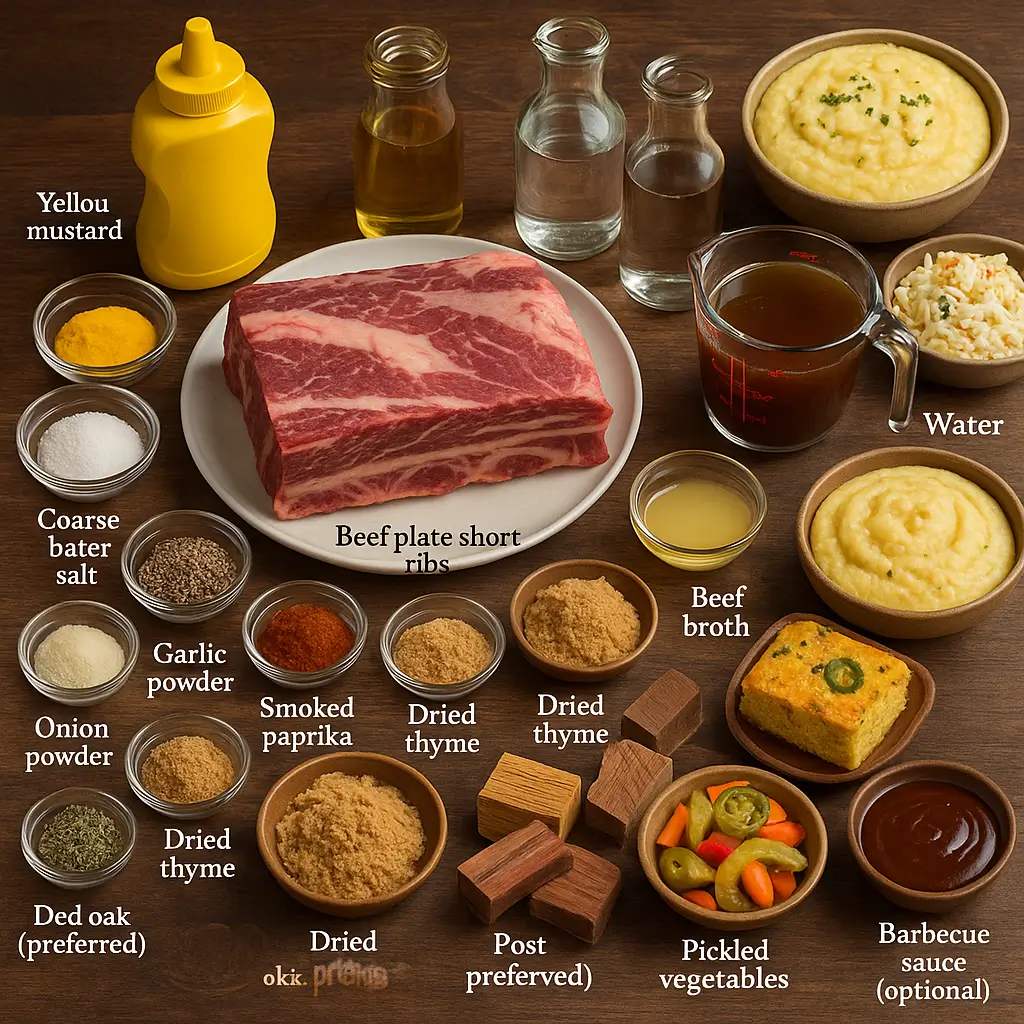
For the Ribs:
- 1 rack beef plate short ribs (3-4 lbs)
- 2 tablespoons yellow mustard (binder)
For the Umami Bomb Rub:
- 3 tablespoons coarse kosher salt
- 2 tablespoons coarse black pepper
- 2 tablespoons garlic powder
- 1 tablespoon onion powder
- 1 tablespoon smoked paprika
- 1 tablespoon brown sugar
- 1 tablespoon beef bouillon powder
- 1 teaspoon dried thyme
For Spritzing:
- 1 cup apple cider vinegar
- 1 cup water
Instructions
- Prep the ribs (30 minutes): Trim fat cap to ¼ inch, remove membrane and silverskin.
- Apply rub (15 minutes): Coat with mustard binder, apply rub generously. Refrigerate 4-24 hours.
- Setup smoker (30 minutes): Preheat to 275°F with preferred wood.
- Initial smoke (4-6 hours): Place ribs bone-side down, maintain clean smoke.
- Spritz phase (2-4 hours): Begin spritzing every hour after hour 3.
- Wrap decision (variable): At 170-180°F, decide whether to wrap or continue unwrapped.
- Cook to tenderness (2-6 additional hours): Cook until probe slides through like butter (203-210°F).
- Rest (1-4 hours): Wrap tightly, rest in insulated cooler.
- Slice and serve: Cut against grain in ¾-inch slices.
Prep Time: 45 minutes
Cook Time: 8-12 hours
Rest Time: 1-4 hours
Total Time: 10-17 hours
Serves: 4-6 people
Cuisine: American BBQ
Category: Main Dish, Smoked Meat
Frequently Asked Questions
Q: What type of beef ribs are best for smoking?
A: Plate ribs (NAMP 123) are ideal for smoking due to their size, marbling, and fat content. They provide the best meat-to-bone ratio and develop incredible tenderness when smoked properly.
Q: What’s the ideal smoking duration for beef short ribs to achieve optimal tenderness?
A: Plan for 8-12 hours at 275°F, plus 1-4 hours resting time. The exact time depends on size, density, and whether you wrap during cooking.
Q: What temperature should I smoke beef ribs at?
A: 275°F (135°C) is optimal. This temperature breaks down connective tissue effectively without drying out the meat.
Q: Do you wrap beef ribs when smoking?
A: Wrapping is optional but recommended around 170-180°F internal temperature. It helps push through the stall and reduces cooking time while maintaining moisture.
Q: How do I know when beef short ribs are done?
A: Use the probe test—your thermometer should slide through the meat like warm butter with zero resistance, typically at 203-210°F internal temperature.
Q: Why are my smoked beef short ribs tough?
A: Tough ribs are usually undercooked. Continue cooking until they pass the probe test, regardless of internal temperature. Insufficient resting can also cause toughness.
Q: Can I make smoked beef short ribs in a slow cooker?
A: While you can braise short ribs in a slow cooker, you won’t achieve the same bark, smoke flavor, or texture that comes from proper smoking. For indoor cooking, consider using a liquid smoke marinade and finishing under the broiler.
Conclusion
Mastering the art of smoked beef short ribs is a journey that rewards patience, attention to detail, and a willingness to learn from each cook. The moment you slice into perfectly smoked ribs that yield effortlessly to your knife, revealing tender, juicy meat with a perfect smoke ring and crusty bark, you’ll understand why this dish represents the pinnacle of barbecue achievement.
Remember that every smoker is different, every cut of meat is unique, and weather conditions affect your cook. Keep detailed notes, trust the process, and don’t be discouraged if your first attempt isn’t perfect. Even experienced pitmasters are constantly learning and refining their technique.
The satisfaction of serving short ribs smoked to perfection—watching friends and family’s eyes widen with that first bite—makes every hour of preparation and smoking worthwhile. Start your next cookout with confidence, knowing you have the knowledge and techniques to create truly exceptional barbecue.
Ready to take your barbecue game to the next level? Try our complementary easy beef tips recipe for smoked brisket and homemade barbecue sauces to create the ultimate pitmaster feast!
Try our latest beef recipes Beef Tenderloin Tips Recipe or Best Roast Beef Sliders Recipe next! And don’t forget to share your favorite creations with us on our Facebook page

